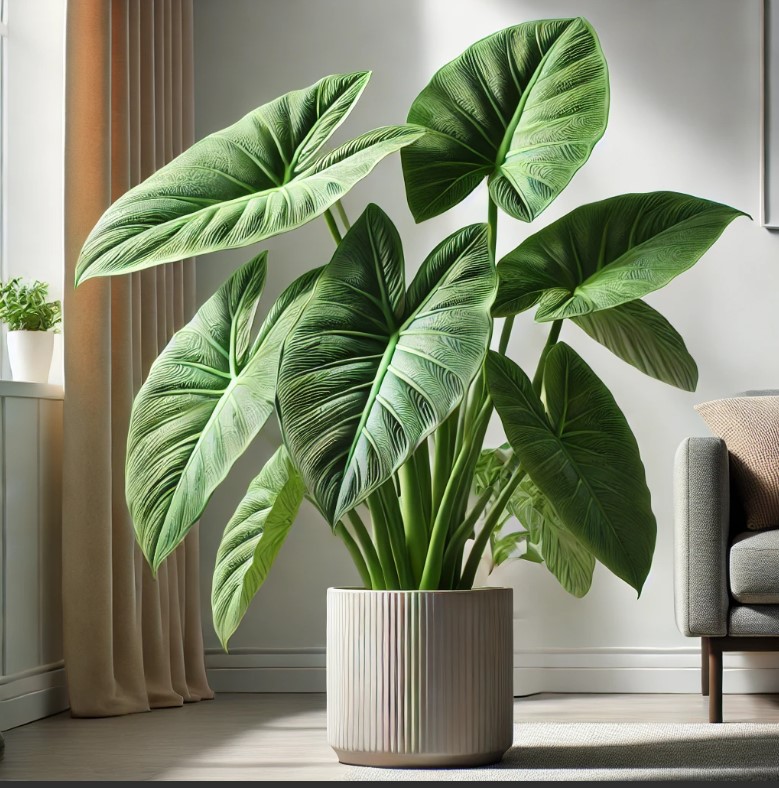Alocasia Forgetti is a highly coveted plant indoors for its captivating foliage and exquisite patterns that mimic the look of wildly growing plants from moist jungles. It needs a little more extra care inside, like the other Alocasia variety! The aim of this article is to cover the care tips you need for keeping your Alocasia Forgetti in a healthy, growing and thriving condition. This guide will offer everything from watering correctly to where the best light is for your plant. It is very essential to know how your Alocasia Forgetti needs you to care in order for it to keep growing and remaining attractive.
1. Making Sense of Alocasia Forgetti
Alocasia Forgetti (a member of the Alocasia family) are ornamentally leafy. Its green leaves with clearly visible veins make the plant a great interior room decoration. Its unique appearance, however, brings with it particularities of care.
2. Light is a major element you must focus on when growing Alocasia Forgetti.
Alocasia Forgetti White enjoys bright but indirect light. Direct sunlight can burn its soft leaves and insufficient light makes this plant weak and leggy.
3. Ideal Conditions for Temperature.
This tropical beauty enjoys the warm temps in the 65°F to 80°F (18°C to 27°C) range. Storing it in a warm environment ensures the product stays strong and healthy.
4. Watering Needs
November 4, 2023 “The Forgetti likes Soil that is kept damp but never soggy like other Alocasias. Only water when the top 1-2 inches of soil have dried out. Root rot is a consequence of overwatering.
5. Humidity needs of Alocasia Forgetti
Alocasia Forgetti does best in high humidity. Higher humidity can be achieved by putting the plant in a humid room, using a humidifier or placing it on a pebble tray with water.
6. Fertilization Tips
Feed your Alocasia Forgetti every 4-6 weeks during the growing season (spring and summer) with a balanced liquid fertilizer. In the fall and winter, during their dormant period, you should reduce feeding.
7. Repotting Alocasia Forgetti
Repot your Alocasia Forgetti every 1 to 2 years in order to replace the soil and allow plenty of room for the plant. Use a pot that is slightly bigger than the one it is currently in.
8. Common Pests to Watch For
Alocasia Forgetti is prone to pests like spider mites, aphids and mealybugs. Inspect your plant from time to time for signs of infestation, spray with suitable insecticidal soap if required.
9. Poor Drainage: Signs of Rotting Roots and Overwatering
Yellowing, wilting or soft, mushy stems may indicate overwatering and root rot. Make sure your pot has drainage, and dont let the plant sit in water.
10. Dealing with Leaf Damage
The tips or edges of the leaves sometimes turn brown on Alocasia Forgetti. Either humidity is low, or you did not water the plant well. This can be fixed by controlling humidity levels and consistently watering them.
11. Pruning Alocasia Forgetti
Minimize any dead or yellowing leaves to keep the plant pushing out healthy new growth. Avoid damaging the plant by using clean sharp scissors or pruning shears.
12. Alocasia Forgetti Propagation
Alocasia Forgetti is usually propagated by dividing it. When repotting, gently pull apart sections of the root ball, making sure each section has a viable root system.
13. How to Fix Leaves that have Turned Yellow?
Yellow leaves are associated with overwatering, a lack of drainage or light. Evaluate and troubleshoot the problem behind their wilting, dying away — check watering habits, light conditions, soil drainage.
14. Alocasia Forgetti Dormancy Explained
Alocasia Forgetti can enter winter dormancy, where the leaves die back. This is a natural process. Cut back watering around this time and leave the plant hibernating until its growth new shoots start emerging in the spring.
15. Designing an Alocasia Forgetti Environment
Balance of light, humidity, water and temperature for a healthy Alocasia Forgetti Learn what these needs are and make small adjustments from time to time, you will manage a flourishing beautiful plant.
Conclusion
Before explaining further about the details of unique care routines, let us tell you that Alocasia Forgetti is a very high maintenance plant and it asks its Carer to pay special attention towards it. By doing so, you will provide a proper habitat for your plant by taking into account its specific requirements, such as light exposure, water demands and humidity tolerance. For the ones who know their plants, your Alocasia Forgetti can become a beautiful piece of art in your house and with regular upkeep, you will have nothing to worry about.This guide will offer everything from watering correctly to where the best light is for your plant. It is very essential to know how your Alocasia Forgetti needs you to care in order for it to keep growing and remaining attractive.Alocasia Forgetti (a member of the Alocasia family) are ornamentally leafy. Its green leaves with clearly visible veins make the plant a great interior room decoration. Its unique appearance, however, brings with it particularities of care.
